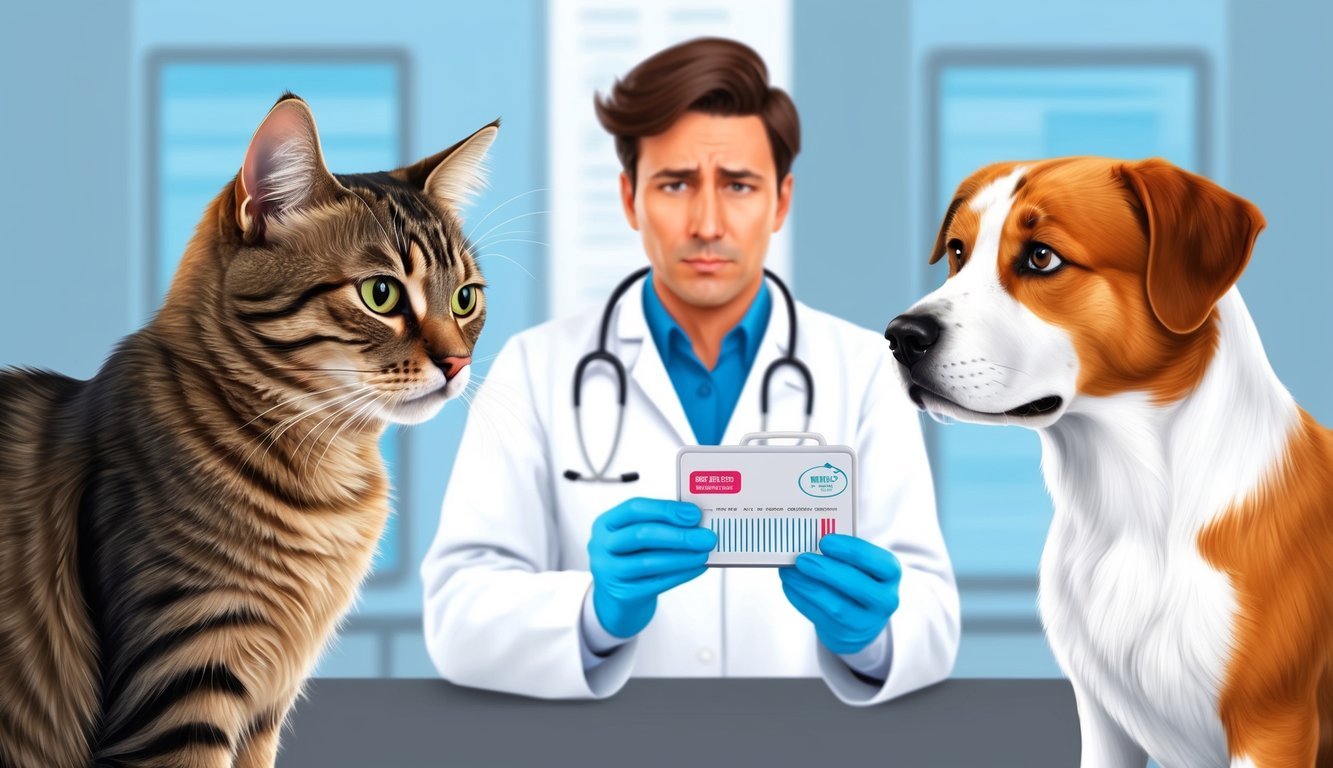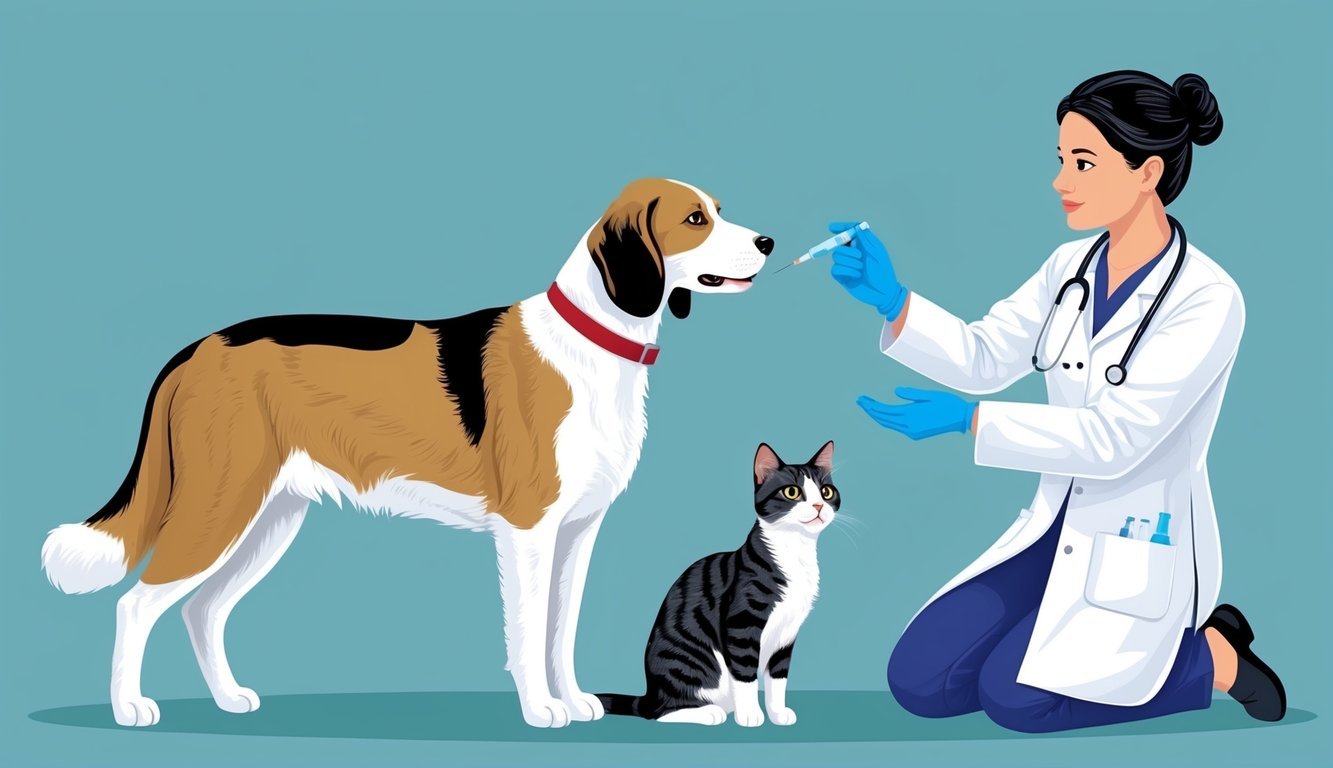Parvovirus often raises questions among cat owners.
Many wonder about the potential risks associated with canine parvovirus.
Cats cannot catch parvo from dogs.
They have their own form of parvovirus known as feline panleukopenia (FPV).
This distinction can provide peace of mind if you have both cats and dogs in your home.
But it doesn’t mean that parvovirus isn’t a serious concern for your feline friend.
Feline panleukopenia can be severe and is highly contagious among cats.
Unlike canine parvovirus, FPV does not affect dogs or humans.
But it’s crucial to understand how it spreads and what you can do to protect your pets.
Knowing the symptoms and the importance of vaccination will help you keep your cat safe and healthy.
By learning more about these viruses, you can be well-equipped to care for your pets.
Understanding the differences can prevent unnecessary worry and ensure you take the right steps to keep all of your furry companions safe.
Key Takeaways
- Cats have their own parvovirus, called feline panleukopenia, which is not transmissible from dogs.
- Vaccination is essential for preventing feline panleukopenia to protect your cat’s health.
- Recognizing the signs of FPV early can lead to timely treatment and a better outcome.
Understanding Parvovirus
Parvovirus affects both felines and canines, but the strains are species-specific.
While they share similar characteristics, the viruses cause different issues in each species.
Knowing about these strains and the symptoms they produce can help you in identifying potential infections in your pets.
The Different Strains of Parvovirus
There are two primary strains of parvovirus relevant to pet owners: Feline Parvovirus (FPV) and Canine Parvovirus (CPV).
FPV exclusively infects cats, leading to severe gastrointestinal symptoms and immunosuppression.
Meanwhile, CPV attacks dogs and is known for causing severe vomiting, diarrhea, and dehydration.
Both strains are highly contagious but do not cross-infect between species.
Researchers have shown that while cats do not typically contract canine parvovirus, there are rare cases where asymptomatic cats can carry CPV without showing symptoms.
Vaccinations are crucial for prevention in both species.
Symptoms of Parvovirus in Cats and Dogs
Symptoms of parvovirus vary between cats and dogs, but both can suffer significantly.
For cats infected with FPV, look for:
- Vomiting
- Severe diarrhea
- Lethargy
- Loss of appetite
In dogs affected by CPV, the following symptoms are common:
- Vomiting (often severe)
- Bloody diarrhea
- Extreme dehydration
- Fever and abdominal pain
Monitoring for these symptoms is essential.
If you notice any, it’s crucial to seek veterinary care promptly.
Early detection increases the chances of effective treatment and recovery.
Transmission of Parvovirus
Understanding how parvovirus spreads can help you take preventive measures for your pets.
Cats and dogs have distinct strains of parvovirus, but the risks of transmission between species exist, albeit at a lower frequency.
Cross-Species Infection Risks
While the parvovirus affecting dogs (canine parvovirus) and the one impacting cats (feline panleukopenia virus) are separate, there are rare cases of cross-species transmission.
Research suggests that canine parvovirus can infect cats under specific conditions, although this is not common.
Your cat might be at risk if in close contact with an infected dog, especially if the dog is asymptomatic.
That said, preventative vaccines exist for both species, significantly reducing these risks.
Monitoring interactions between your pets is essential in maintaining their health.
Common Transmission Pathways
Parvovirus typically spreads through direct contact with infected animals or contaminated environments.
For dogs, the virus manifests primarily in the gastrointestinal tract, leading to severe symptoms like vomiting and diarrhea.
Fomites—objects or surfaces that can carry infectious agents—are also a concern.
If a dog with parvovirus walks through your yard and leaves traces of the virus, your cat could potentially be exposed.
Additionally, the virus can linger for months in the environment, making regular cleaning crucial.
Ensuring that your pets are vaccinated and limiting their interactions can greatly reduce the chance of transmission.
Diagnosing Parvovirus in Cats

Recognizing and diagnosing parvovirus in cats, specifically Feline Panleukopenia Virus (FPV), is crucial for effective treatment.
Understanding the differences between feline and canine viruses aids in accurate diagnosis and management.
Comparison of Canine Parvovirus and Feline Panleukopenia
While both canine and feline parvoviruses share some similarities, they target different species.
Canine parvovirus (CPV) primarily affects dogs, whereas FPV specifically infects cats.
Key Differences:
- Transmission: Canine parvovirus cannot be transmitted to cats.
- Symptoms: Dogs may present with severe gastrointestinal issues, while cats often exhibit lethargy, fever, and loss of appetite.
- Vaccination: Vaccines exist for both strains, but they are tailored to each species.
It’s essential to be aware of the symptoms unique to FPV so that you can seek veterinary assistance promptly.
Testing and Identification of Parvovirus
Diagnosing FPV typically begins with a thorough clinical examination.
Your veterinarian will consider your cat’s history, current symptoms, and conduct specific tests.
Common Tests Include:
- Fecal Tests: A commonly used method to check for the presence of the virus. False positives can occur, so additional testing may be necessary.
- Blood Tests: These can determine white blood cell counts and overall health status.
If your cat is suspected of having FPV, timely testing is vital.
Early detection can significantly affect the treatment options and outcomes.
Treatment Strategies for Feline Panleukopenia

When dealing with feline panleukopenia, timely intervention is crucial.
You must focus on both immediate care and ongoing management to improve the chances of recovery.
Immediate Care and Stabilization
The first step in treating feline panleukopenia is stabilization.
If your cat shows signs of severe dehydration, administer subcutaneous (SC) fluids to rehydrate them.
This can help restore normal bodily functions quickly.
Monitor for signs of sepsis, as this can complicate treatment.
High fever, lethargy, and pale gums are indicators.
Providing supportive care like antibiotics can be effective in controlling bacterial infections.
Use parvovirus test kits for prompt diagnosis.
Early recognition allows for timely treatment of complications.
Medications like Neupogen (filgrastim) may support white blood cell recovery.
Ensuring a stress-free environment aids in the recovery process.
Ongoing Treatment and Management
Once your cat is stabilized, ongoing treatment focuses on supportive care.
Continue IV fluids to prevent dehydration.
Adding electrolytes may be necessary, as they can help maintain balance.
Monitor your cat’s nutritional needs closely.
Offer easily digestible food to encourage eating.
In some cases, appetite stimulants can be useful.
Regular veterinary check-ups are essential.
They help ensure your cat’s recovery is on track.
Frequent blood tests can guide you on white blood cell counts and detect potential complications early.
Stay vigilant for symptoms that may indicate a setback, such as vomiting or persistent diarrhea.
Such issues should be addressed immediately to prevent further health risks.
Prevention and Vaccination

Vaccination plays a crucial role in preventing parvovirus in cats and maintaining the health of multi-pet households.
Understanding the vaccination schedules and their importance can help you ensure the safety of your pets.
Vaccination Schedules for Cats and Dogs
For cats, the Feline Parvovirus (FPV) vaccine is typically administered to kittens between 6 to 8 weeks of age.
This vaccination continues with boosters every 3 to 4 weeks until they reach about 16 weeks.
Adult cats should receive booster vaccinations every 3 years.
Dogs, on the other hand, need the Canine Parvovirus vaccination.
Puppies generally start their vaccinations at 6 to 8 weeks with boosters every 3 to 4 weeks until they are around 16 to 18 weeks old.
Adult dogs also require boosters, typically every 3 years.
You can consult your veterinarian for specific schedules based on your pets’ needs and lifestyle.
Importance of Vaccination in Multi-Pet Households
If you have both cats and dogs, vaccination is essential to reduce the risk of transmitting viruses.
Although cats cannot get canine parvovirus, both species can have separate types of parvovirus that are harmful to them.
In multi-pet environments, vaccinating pets ensures that they are better protected from various diseases.
Regular check-ups with your veterinarian will help you keep track of vaccinations and assess any potential risks.
By ensuring that all pets are vaccinated, you create a healthier home for everyone.
Vaccination not only protects individual pets but also helps prevent outbreaks in a shared living space.
Myths and Misconceptions About Parvo

There are several myths surrounding parvovirus, particularly regarding its impact on cats and dogs.
Clearing up these misconceptions is crucial for responsible pet ownership.
Feline Parvo vs. Feline Distemper
One common misconception is that feline parvovirus is the same as feline distemper.
While both are serious illnesses, they are caused by different viruses.
-
Feline Parvovirus (FPV) primarily leads to Feline Infectious Enteritis. It attacks the intestinal cells, causing severe gastrointestinal distress.
-
Feline Distemper, on the other hand, is caused by a completely different virus and affects the nervous system.
It’s important to recognize the distinction, as vaccinations for each disease are tailored specifically to their respective viruses.
Keeping your cat vaccinated against both can help prevent these serious health issues.
Misinformation Around Cross-Species Transmission
Another prevalent myth is that cats can contract parvovirus from dogs.
This is inaccurate.
-
The strain that infects dogs, known as canine parvovirus (CPV-2), does not infect cats.
-
Felines are susceptible to their own variant, feline parvovirus (FPV), which is not transmitted from dogs.
Understanding this helps you focus on the right vaccinations.
Your cat can be vaccinated against FPV without concern for exposure from canine sources.
Keeping up with vaccinations ensures your pet’s health and reduces the risk of infection.
Living with a Parvo Survivor

When you have a cat who has survived feline panleukopenia (commonly referred to as parvo), managing their health and ensuring a safe environment is crucial.
The following sections focus on monitoring their ongoing health and the necessary steps for environmental decontamination.
Managing Long-Term Health
After your cat recovers from feline panleukopenia, they may need ongoing health management.
Regular veterinary check-ups are essential to monitor any long-term effects.
You should keep an eye on their weight, nutrition, and overall vitality.
Dietary Needs
Consider a high-quality, easily digestible diet that addresses any specific health concerns.
Your vet can provide recommendations tailored to your cat’s needs.
Vaccinations
Make sure your cat receives booster vaccines as advised by your veterinarian.
This helps prevent future infections and strengthens their immune system.
Behavioral Changes
Watch for any unusual behaviors or signs of distress, which may be indicators of lingering health issues.
Early intervention can be key to addressing complications.
Environmental Decontamination
Keeping your home safe from the parvovirus is vital, as it can survive on surfaces (fomites) for long periods.
Here’s how to protect your space:
Clean Surfaces
Use a solution of bleach and water (1:32 ratio) to disinfect areas your cat frequents.
Pay special attention to litter boxes, food bowls, and any toys.
Remove Fomites
Wash all bedding and any soft materials in hot water.
Items like blankets, toys, and cushions should be thoroughly cleaned or discarded if they can’t be sanitized.
Quarantine New Pets
If you plan to introduce another animal, keep them separated for at least two weeks.
This helps prevent any potential transfer of diseases.
Taking these steps can help ensure your cat’s continued health and safeguard your home against the virus.
Frequently Asked Questions

When it comes to parvo, understanding its effects and transmission can be crucial for your cat’s health.
Here are some common questions that many pet owners have regarding parvovirus and its relation to cats.
How contagious is parvo to cats?
Feline parvovirus, or feline panleukopenia virus (FPV), is specific to cats.
It is not contagious to them from dogs.
Cats can catch FPV from other infected cats or contaminated environments.
What are the stages of parvo in cats?
Parvo in cats typically progresses through several stages.
After exposure, symptoms may appear within 7-14 days.
Initially, your cat might show signs of lethargy, followed by gastrointestinal symptoms like vomiting and diarrhea.
How can I tell if my cat has parvo?
Signs of parvo in cats include lethargy, loss of appetite, vomiting, and diarrhea.
If you notice any of these symptoms, it is essential to consult your veterinarian promptly for a proper diagnosis and treatment plan.
Can dogs transmit diseases to cats, including parvo?
Dogs cannot transmit parvovirus to cats.
While both species can suffer from parvo, the viruses affecting each are species-specific.
Therefore, your cat is safe from contracting feline parvo from a dog.
Is it possible for dogs to spread parvo to humans?
Dogs do not spread parvovirus to humans.
Parvovirus is specific to canines and felines and poses no risk to human health.
You can rest assured that you won’t contract parvo from your dog.
What are the best practices for treating parvo in cats at home?
Treating parvo in cats typically requires veterinary care, but you can manage supportive care at home.
Ensure your cat stays hydrated.
Provide a balanced diet and monitor their symptoms closely.
Always consult your veterinarian for personalized treatment recommendations.


